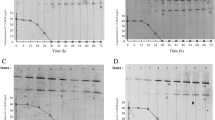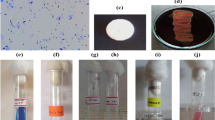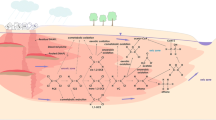Abstract
Chlorobenzene (CB), extensively used in industrial processes, has emerged as a significant contaminant in soil and groundwater. The eco-friendly and cost-effective microbial remediation has been increasingly favored to address this environmental challenge. In this study, a degrading bacterium was isolated from CB-contaminated soil at a pesticide plant, identified as Pandoraea sp. XJJ-1 (CCTCC M 2021057). This strain completely degraded 100 mg·L−1 CB and showed extensive degradability across a range of pH (5.0–9.0), temperature (10–37 °C), and CB concentrations (100–600 mg·L−1). Notably, the degradation efficiency was 85.2% at 15 °C, and the strain could also degrade six other aromatic hydrocarbons, including benzene, toluene, ethylbenzene, and xylene (o-, m-, p-). The metabolic pathway of CB was inferred using ultraperformance liquid chromatography, gas chromatography-mass spectrometry, and genomic analysis. In strain XJJ-1, CB was metabolized to o-chlorophenol and 3-chloroxychol by CB monooxygenase, followed by ortho-cleavage by the action of 3-chlorocatechol 1,2-dioxygenase. Moreover, the presence of the chlorobenzene monooxygenation pathway metabolism in strain XJJ-1 is reported for the first time in Pandoraea. As a bacterium with low-temperature resistance and composite pollutant degradation capacity, strain XJJ-1 has the potential application prospects in the in-situ bioremediation of CB-contaminated sites.





Similar content being viewed by others
Data availability
All data supporting the findings of this study are available within the paper and its Supplementary Information.
References
Alghuthaymi MA, Awad AM (2022) Isolation and characterization a novel catabolic gene cluster involved in CB degradation in haloalkaliphilic Alcanivorax sp. HA03. Biology 11:724. https://doi.org/10.3390/biology11050724
Baptista IR, Zhou NY, Emanuelsson EAC, Peeva LG, Leak DJ, Mantalaris A, Livingston AG (2008) Evidence of species succession during chlorobenzene biodegradation. Biotechnol Bioeng 99(1):68–74. https://doi.org/10.1002/bit.21576
Braeckevelt M, Reiche N, Trapp S, Wiessner A, Paschke H, Kuschk P, Kaestner M (2011) Chlorobenzene removal efficiencies and removal processes in a pilot-scale constructed wetland treating contaminated groundwater. Ecol Eng 37(6):903–913. https://doi.org/10.1016/j.ecoleng.2011.01.014
Chao HJ, Chen YY, Wu J, Yan DZ, Zhou NY (2019) Complete genome sequence of a chlorobenzene degrader, Pandoraea pnomenusa MCB032. Curr Microbiol 76(11):1235–1237. https://doi.org/10.1007/s00284-019-01760-2
Chen X, Shan GB, Shen JM, Zhang F, Liu YD, Cui CZ (2023) In situ bioremediation of petroleum hydrocarbon-contaminated soil: isolation and application of a Rhodococcus strain. Int Microbiol 26(2):411–421. https://doi.org/10.1007/s10123-022-00305-1
Cheng ZW, Li C, Kennes CT, Ye JX, Chen DZ, Zhang SH, Chen JM, Yu JM (2017) Improved biodegradation potential of chlorobenzene by a mixed fungal-bacterial consortium. Int Biodeterior Biodegradation 123:276–285. https://doi.org/10.1016/j.ibiod.2017.07.008
Choi EJ, ** HM, Lee SH, Math RK, Madsen EL, Jeon CO (2013) Comparative genomic analysis and benzene, toluene, ethylbenzene, and o-, m-, and p-xylene (BTEX) degradation pathways of Pseudoxanthomonas spadix BD-a59. Appl Environ Microbiol 79(2):663–671. https://doi.org/10.1128/aem.02809-12
Fuchs G, Boll M, Heider J (2011) Microbial degradation of aromatic compounds - from one strategy to four. Nat Rev Microbiol 9(11):803–816. https://doi.org/10.1038/nrmicro2652
Hu WL, Pang M, Li L, Yu WC, Mou Y, Wang H, Lian Y (2020) High-throughput speciation of triethyl tin, tributyl tin, and triphenyl tin in environmental water by ultra-performance liquid chromatography-tandem mass spectrometry (UPLC-MS/MS). Anal Lett 54:2022–2036. https://doi.org/10.1080/00032719.2020.1833341
Jiang XW, Liu H, Xu Y, Wang SJ, Leak DJ, Zhou NY (2009) Genetic and biochemical analyses of chlorobenzene degradation gene clusters in Pandoraea sp. strain MCB032. Arch Microbiol 191(6):485–492. https://doi.org/10.1007/s00203-009-0476-9
Kaschl A, Vogt C, Uhlig S, Nijenhuis I, Weiss H, Kastner M, Richnow HH (2005) Isotopic fractionation indicates anaerobic monochlorobenzene biodegradation. Environ Toxic Environ Chem 24(6):1315–1324. https://doi.org/10.1897/04-321R.1
Kiernicka J, Seignez C, Peringer P (1999) Escherichia hermanii-a new bacterial strain for chlorobenzene degradation. Lett Appl Microbiol 28(1):27–30. https://doi.org/10.1046/j.1365-2672.1999.00475.x
Kumar S, Stecher G, Li M, Knyaz C, Tamura K (2018) MEGA X: molecular evolutionary genetics analysis across computing platforms. Mol Biol Evol 35(6):1547–1549. https://doi.org/10.1093/molbev/msy096
Lee Y, Lee Y, Jeon CO (2019) Biodegradation of naphthalene, BTEX, and aliphatic hydrocarbons by Paraburkholderiaaromaticivorans BN5 isolated from petroleum-contaminated soil. Sci Rep 9(1):860. https://doi.org/10.1038/s41598-018-36165-x
Li H, Liu YH, Luo N, Zhang XY, Luan TG, Hu JM, Wang ZY, Wu PC, Chen MJ, Lu JQ (2006) Biodegradation of benzene and its derivatives by a psychrotolerant and moderately haloalkaliphilic Planococcus sp. strain ZD22. Res Microbiol 157(7):629–636. https://doi.org/10.1016/j.resmic.2006.01.002
Mars AE, Kasberg T, Kaschabek SR, Agteren MH, Janssen DB, Reineke W (1997) Microbial degradation of chloroaromatics: use of the meta-cleavage pathway for mineralization of chlorobenzene. J Bacteriol 179(14):4530–4537. https://doi.org/10.1128/jb.179.14.4530-4537.1997
Monferran MV, Echenique JR, Wunderlin DA (2005) Degradation of chlorobenzenes by a strain of Acidovorax avenae isolated from a polluted aquifer. Chemosphere 61(1):98–106. https://doi.org/10.1016/j.chemosphere.2005.03.003
Nelson MJ, Montgomery SO, Mahaffet WR, Pritchatd PH (1987) Biodegradation of trichloroethylene and involvement of an aromatic biodegradative pathway. Appl Environ Microbiol 53(5):949–954. https://doi.org/10.1128/aem.53.5.949-954.1987
Nguyen OT, Ha DD (2019) Degradation of chlorotoluenes and chlorobenzenes by the dual-species biofilm of Comamonas testosteroni strain KT5 and Bacillus subtilis strain DKT. Ann Microbiol 69(3):267–277. https://doi.org/10.1007/s13213-018-1415-2
Nishino SF, Spain JC, Belcher LA, Litchfield CD (1992) Chlorobenzene degradation by bacteria isolated from contaminated groundwater. Appl Environ Microbiol 58(5):1719–1726. https://doi.org/10.1128/aem.58.5.1719-1726.1992
Pettigrew CA, Haigler BE, Spain JC (1991) Simultaneous biodegradation of chlorobenzene and toluene by a Pseudomonas strain. Appl Environ Microbiol 57(1):157–162. https://doi.org/10.1128/aem.57.1.157-162.1991
Potrawfke T, Timmis KN, Wittich RM (1998) Degradation of 1,2,3,4-tetrachlorobenzene by Pseudomonas chlororaphis RW71. Appl Environ Microbiol 64(10):3798–3806. https://doi.org/10.1128/AEM.64.10.3798-3806.1998
Rehfuss M, Urban J (2005) Rhodococcus phenolicus sp. nov., a novel bioprocessor isolated actinomycete with the ability to degrade chlorobenzene, dichlorobenzene and phenol as sole carbon sources. Syst Appl Microbiol 28(8):695–701. https://doi.org/10.1016/j.syapm.2005.05.011
Reineke W, Knackmuss HJ (1984) Microbial metabolism of haloaromatics: isolation and properties of a chlorobenzene-degrading bacterium. Appl Environ Microbiol 47(2):395–402. https://doi.org/10.1128/aem.47.2.395-402.1984
Sun XC, Gu XG, Lyu SG (2021) The performance of chlorobenzene degradation in groundwater: comparison of hydrogen peroxide, nanoscale calcium peroxide and sodium percarbonate activated with ferrous iron. Water Sci Technol 83(2):344–357. https://doi.org/10.2166/wst.2020.587
van der Meer JR (1997) Evolution of novel metabolic pathways for the degradation of chloroaromatic compounds. Antonie Van Leeuwenhoek 71:159–178. https://doi.org/10.1023/a:1000166400935
van der Meer JR, Eggen RI, Zehnder AJ, de Vos WM (1991) Sequence analysis of the Pseudomonas sp. strain P51 tcb gene cluster, which encodes metabolism of chlorinated catechols: evidence for specialization of catechol 1,2-dioxygenases for chlorinated substrates. J Bacteriol 173(8):2425–2434. https://doi.org/10.1128/jb.173.8.2425-2434.1991
van der Meer JR, Werlen C, Nishino SF, Spain JC (1998) Evolution of a pathway for chlorobenzene metabolism leads to natural attenuation in contaminated groundwater. Appl Environ Microbiol 64(11):4185–4193. https://doi.org/10.1128/AEM.64.11.4185-4193.1998
Vyas TK, Murthy SR (2015) Chlorobenzene degradation by Bacillus sp. TAS6CB: a potential candidate to remediate chlorinated hydrocarbon contaminated sites. J Basic Microbiol 55(3):382–388. https://doi.org/10.1002/jobm.201200758
Wackett LP, Gilbson DT (1988) Degradation of trichloroethylene by toluene dioxygenase in whole-cell studies with Pseudomonas putida F1. Appl Environ Microbiol 54(7):1703–1708. https://doi.org/10.1128/aem.54.7.1703-1708.1988
Wang C, ** JY, Hu HY, Wen XH (2008) Biodegradation of gaseous chlorobenzene by white-rot fungus Phanerochaete chrysosporium. Biomed Environ Sci 21(6):474–478. https://doi.org/10.1016/S0895-3988(09)60005-2
Werlen C, Kohler HP, van der Meer JR (1996) The broad substrate chlorobenzene dioxygenase and cis-chlorobenzene dihydrodiol dehydrogenase of Pseudomonas sp. strain P51 are linked evolutionarily to the enzymes for benzene and toluene degradation. J Biol Chem 271(8):4009–4016. https://doi.org/10.1074/jbc.271.8.4009
Wu M, Zhao ZN, Cai GJ, Duan W, Wang CJ, Cheng GB, Wang XK (2022) In situ evaluation of soil contaminated by total petroleum hydrocarbons using membrane interface probe: a case study from Nan**g, China. Bull Eng Geol Env 81(4):140. https://doi.org/10.1007/s10064-022-02639-6
**e SW, Yuan SH, Liao P, Jia MQ, Wang Y (2015) Pd-catalytic hydrodechlorination of chlorinated hydrocarbons in groundwater using H2 produced by a dual-anode system. Water Res 86:74–81. https://doi.org/10.1016/j.watres.2015.07.026
**e RJ, Cao JP, **e XW, Lei DX, Guo KH, Liu H, Zeng YX, Huang HB (2020) Mechanistic insights into complete oxidation of chlorobenzene to CO2 via wet scrubber coupled with UV/PDS. Chem Eng J 401:126077. https://doi.org/10.1016/j.cej.2020.126077
Xu J, Wang F, Sun C, Zhang XL, Zhang YH (2019) Gas thermal remediation of an organic contaminated site: field trial. Environ Sci Pollut Res Int 26(6):6038–6047. https://doi.org/10.1007/s11356-018-4027-2
Ye JX, Lin TH, Luo YH, Chen DZ, Chen JM (2017) Isolation and identification of a chlorobenzene-degrading bacterium and its degradation characteristics. Huan **g Ke Xue 38(2):802–808. https://doi.org/10.13227/j.hjkx.201607198
Yu M, Luo ZJ, Wang YX, Li JX (2018) Chlorobenzenes contamination in soils/sediments at a site of decommissioned plant in Central China. J Earth Sci 29(3):639–645. https://doi.org/10.1007/s12583-018-0833-1
Zhang LL, Leng SQ, Zhu RY, Chen JM (2011) Degradation of chlorobenzene by strain Ralstonia pickettii L2 isolated from a biotrickling filter treating a chlorobenzene-contaminated gas stream. Appl Microbiol Biotechnol 91(2):407–415. https://doi.org/10.1007/s00253-011-3255-x
Zhang S, Ying Z, You J, Ye J, Cheng Z, Chen D, Chen J (2019) Superior performance and mechanism of chlorobenzene degradation by a novel bacterium. RSC Adv 26(9):15004–15012. https://doi.org/10.1039/c9ra01229j
Funding
This work was supported by the Science and Technology Commission of Shanghai Municipality (No.23HC1400300) and CNPC Innovation Found (No.2022DQ02-0504).
Author information
Authors and Affiliations
Contributions
Changzheng Cui and Jie Yang conceived the idea and designed the experiments. Lixu Pan and Bo Yuan conducted the experiments, analyzed the data, and prepared the first draft of the manuscript. Qingqing Li, Ji Ouyang, Yan Zhou, and Changzheng Cui reviewed and revised the manuscript. All authors have reviewed and approved the final manuscript.
Corresponding author
Ethics declarations
Ethics approval
This is an observational study. The East China University of Science and Technology Research Ethics Committee has confirmed that no ethical approval is required.
Consent to participate
Not applicable.
Consent for publication
Not applicable.
Competing interests
The authors have no relevant financial or non-financial interests to disclose.
Additional information
Publisher's Note
Springer Nature remains neutral with regard to jurisdictional claims in published maps and institutional affiliations.
Supplementary Information
Below is the link to the electronic supplementary material.
Rights and permissions
Springer Nature or its licensor (e.g. a society or other partner) holds exclusive rights to this article under a publishing agreement with the author(s) or other rightsholder(s); author self-archiving of the accepted manuscript version of this article is solely governed by the terms of such publishing agreement and applicable law.
About this article
Cite this article
Pan, L., Yuan, B., Li, Q. et al. Efficient biodegradation of chlorobenzene via monooxygenation pathways by Pandoraea sp. XJJ-1 with high potential for groundwater bioremediation. Int Microbiol (2024). https://doi.org/10.1007/s10123-024-00544-4
Received:
Revised:
Accepted:
Published:
DOI: https://doi.org/10.1007/s10123-024-00544-4




